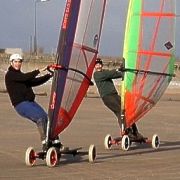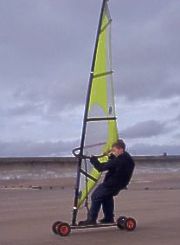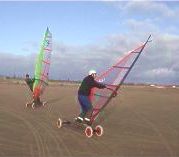|

WINDSURFING: Speedsailing
About Speed-sailing Where
to practice Safety Speedsailing
at HSSC
Our fleet Equipment
Looking after and tuning your kit
|


This page
has been prepared
by Antoine Breton

Racing at Dymchurch

Junior
Speedsailing

Gybing
|
Introduction Are
you looking for a way to keep fit during winter when the water is too
cold? Do you miss your windsurfing during those gloomy winter months?
Well, unless you can afford to travel for 6 months each year in some nice,
warm windy country, then speed-sailing might be just what you are looking
for. This page will tell you everything you need to know about
speed-sailing at HSSC, including…
About Speed-sailing back
to the top
The famous windsurfer Arnaud de Rosnay invented the Speed-sail in the
seventies. He proved its efficiency by crossing the desert between
Nouadhibou (Mauritania) and Dakar (Senegal), a distance of approximately
1380 km (860 miles). Thirty years later it is still an active sport, with
a yearly production of around 500 Speed-sails per year, and as many as
2000 per year in the past.
A Speed-sail is basically a big skateboard, designed to operate on sand
using windsurfing sails for power. Speed-sailing is more than just a
winter sport, and whether or not you have a "beach" lifestyle,
it could well be for you. Imagine a crisp, sunny winter's weekend, spend
playing on the sand like children and having a whale of a time! And you
don't even have to leave your family behind; unlike windsurfing, its easy
for everyone to join in.
Where to practice
back
to the top
The beaches of the north coast in France are well known places to
practice, e.g. Le Touquet, Hardelot, Berck etc. But we also do have some
very good places in Kent as well, including Sandwich bay, Dymchurch,
Greatstone, Littlestone and the beach at Camber. These spots can be just
as good as any of the well known beaches in France. Many other places to
Speed-sail exist in England. Cornwall offers great beaches for this sport
and is where the British Speed-sailing association is based. Click
here to visit their web-site.
|
Safety
back
to the top
 |
First of all, be "the gentleman of
the beach". Leave a good distance between pedestrians
(especially children) and yourself. |
 |
For your own safety, avoid getting too
close to dogs, as some of them love biting the tyres (or legs!). At
Camber, be nice to the horses and keep well away from them. These
animals can easily get scared by the bright sails. Also avoid the
area with Kite buggies, they travel very fast and their lines can be a
potential hazard. |
 |
Look after your own safety. Keep your
equipment in good condition. Be careful when you start your
speed-sailing session. Take it easy for the 10 first minutes to warm
up. It will be less painful when you will fall; sand is harder than
you think! |
 |
Use your warming-up time to check the
sand condition. Soft sand cannot be identified until you are on it.
You can be seriously "catapulted" when hitting a soft sand
area. |
 |
Whatever happens to the sail, you should
remember to always do your best to stay on the board. Stepping down
from a fast moving speed-sail can be seriously painful. |
 |
As you don't have any brakes, its easy
to go too fast. In this case, heading upwind and pushing your sail
into the wind is the only way to stop. Never get trapped downwind. |
 |
Your first gybes: slow down by heading
upwind then commence the gybe by steering the board firmly. Important:
keep on steering to avoid being trapped downwind. |
 |
Consider protection devices such as a
crash helmet. |
 |
Be insured. You are on wheels and if you
hit anyone you will be liable. The British Speed-sail association
provides licences and insurance. You can also check if your personal
liability insurance will cover you (contact your insurer) |
 |
Last and not least, respect priority rules
and these are not the ones you use with your car! They are similar to
Sailing . The speed-sail operating with the wind coming from starboard
has priority. If two speed sails are receiving the wind from the same
direction, the upwind one has priority.
|
Speed-sailing at HSSC
back
to the top
 |
The speed-sail section was created in
2000. It is run by the Windsurfing Rear Commodore, Antoine Breton. |
 |
As a club member, you will put you on a
distribution list (if you want) informing you of friendly events
organised by the club. |
 |
We are organising friendly races throughout
the year, as well as trips to France. |
 |
Joining a group means having fun
together, challenging your style with the others, improving safety
as someone can help you if you have an accident, and sharing the
cost of travel when travelling to events. |
 |
So why not contact us and join now!
E-mail Antoine for more information: mailto:windsurfing@hssc.net
|
Our fleet (last
updated Jan 2001) back
to the top
 |
Antoine Breton: 1,90 Race (1999) |
 |
Mark Brooks: 1,90 Race (1996) |
 |
Ben Brooks: 1,90 Race (2001) |
 |
Oliver Brooks: Mountain Board prototype
(2000) |
 |
Andy Gibson: 1,90 Race (1997) |
 |
Rob Macpherson: 1,90 Race (2000) |
 |
Dave Finch: 1,90 Race (2001) |
 |
Bruce Yule: 1,90 Race (1980) |
 |
Roger Gosbee: 1,90 Race (2001) |
 |
Simon Clarke: 1,90 Race (2001) |
 |
Barry Farnes: 1,90 Race (2001) |
 |
Ben Clifford: 1,90 Race (2001) |
 |
Elliot Carney: Mountain Board prototype
(2000) |
 |
Marc Carney: Prototype (1,90) Race |
Equipment
back
to the top
Different types of Speed-sail board exist. The manufacturer of
Speed-sail is Norbert Blanc in France. Click
here and visit their Web site (English version provided) to see the
whole range of products and also some interesting historical pictures.
 |
The most common board is the Race model,
which is 1.9m in length. |
 |
The sails are the same you use on a
windsurf board, although for the same windspeed, you will use
smaller sails than on your windsurf board. The classic sail size be
5m˛ for a 12 stone Speed-sailor. From that you can use down to 4
m˛ sail or even lower when the wind is more than 20 knots. For
light wind you can consider up to something like 6.6 m˛. |
 |
Your boom will suffer, as the sand will
scuff off the protection, so an old boom is your best bet. |
 |
Its up to you whether or not you use a
harness. If you go for long runs looking for maximum speed you will
probably need one. If you prefer slalom and freestyle and building
up muscles by gybing every 15 sec, then you don’t need one, and in
fact it can be dangerous if you get hooked in during a gybe by
mistake. |
 |
For yourself, waterproof trousers are
really quite important. Also an old pair of sports shoes (they will
get wet, so why not invest in some waterproof socks). If you prefer
to keep warm feet a pair of sailing boots with flat bottom is a good
choice. |
Looking
after and tuning your kit
back
to the top
 |
The speed sail is made of aluminium,
wood, plastic and non-stainless steel bearings. If you want it to
last, wash it after use with fresh water and let it dry. |
 |
The bearings are the most important
things to look after. More recent ones are sealed and greased for
life. When assembling your speed sail, grease the axles and also the
outside of the bearing to limit corrosion (use silicone or marine
grease). |
 |
Remove the wheels if you do not intend
to use it for a long time. In the long term the metal bearing on
aluminium axle could corrode due to the different nature of the
metals. |
 |
The board does not like large
temperature changes, so be careful in summer inside your car. |
 |
You can adjust the settings of the
trucks: loosening them will give you a more feel, good for slalom
and freestyle. Tightening them up will provide a "stiffer"
and more stable feel, good if you are looking for maximum speed and
long runs (also good for beginners). |

Back to the top
[Next
page in Tour] [Site map] [Reload frameset] [E-mail]
WINDSURFING:
Speedsailing
 |




